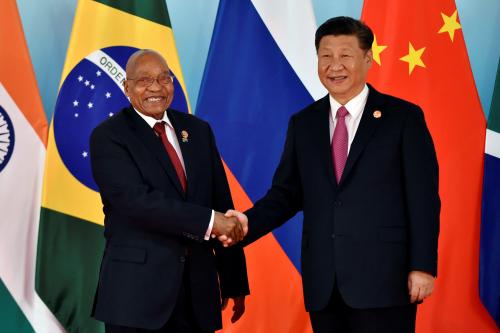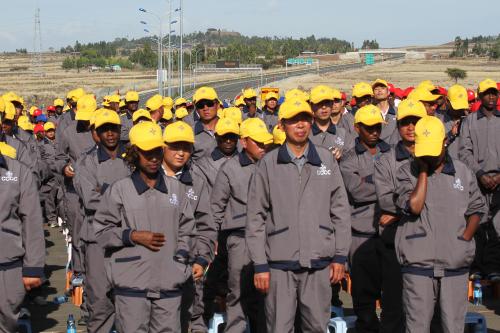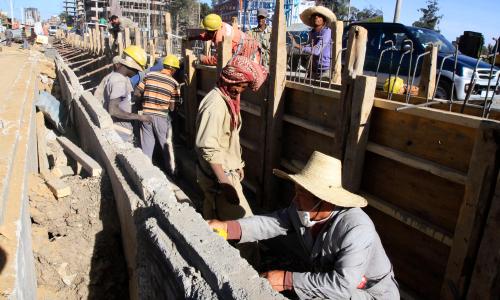When it comes to Africa, it is no secret that the United States and China have very different philosophies. China adopts a more state-led approach, with state-owned enterprises and policy banks spearheading Africa’s infrastructure development. The U.S. is more willing to let private companies and the market take the lead on commercial development, while the U.S. government itself puts more emphasis on the continent’s capacity building and governance challenges.
A long-standing question has been whether these two powerhouses could join forces and cooperate to advance Africa’s development. Such discussions have happened between the two governments. In 2014, it was reported that Obama’s signature Power Africa initiative was considering partnership with China on improving electricity in Africa. Around the same time, China reportedly approached the U.S. on collaboration on the ambitious Inga-3 hydropower projects in the Democratic Republic of the Congo. However, years have gone by without much progress on these speculations due to multiple considerations, especially political, economic, and reputational.
As China expands its Belt and Road Initiative (BRI) in Africa, government-level U.S.-China cooperation in Africa continues to be scarce. However, this trend contrasts sharply with the growing collaboration between Chinese and American companies in infrastructure projects on the continent. Indeed, although the Chinese projects and financing have the tradition of favoring Chinese contractors and providers, the technical advantages of some American companies have made them the beneficiary of the Chinese BRI campaign.
Multinational industrial giants appear to be winning substantially by partnering with major Chinese state-owned players in Africa. From early on, General Electric (GE) had come “fully prepared to partnering with mainland financial juggernauts, infrastructure builders, power producers to tap the business potential” along the Belt and Road. As early as 2015, GE partnered with China Machinery Engineering Corporation (CMEC) on the Kipeto wind farm. While GE provides machinery, equipment, tech support, and training, CMEC is the project contractor. Strictly speaking, Kipeto wind farm is not a Chinese project given that CMEC was only the contractor, but it has paved the way to more diverse and in-depth cooperation between GE and other Chinese companies in Africa.
More recently, GE has been working with the state-owned Power Construction Corporation of China (Power China) to build power plants and grids in African countries such as Nigeria. In November of 2017, the two companies launched a roadshow in Nigeria, Ethiopia, and Kenya, during which they showcased an in-depth market report on Nigeria’s grid system in response to challenges identified by the two companies in powering the country. The report represents a shift toward more proactive market development efforts to ensure that projects along the Belt and Road not only solve their primary goals of generating power at the source, but also provide a long-sighted view of benefits for end-users and effectively distribute power according to the country’s energy needs. Toward this end, a memorandum of understanding was signed between GE and Power China.
GE’s cooperation with Power China is believed to be an evolution and expansion of the previous EPC (engineering, procurement, and construction) project model for which Chinese infrastructure companies are famous. The Chinese and American companies are expanding beyond the tradition EPC role of Chinese contractors into the fields of “joint market development, joint fundraising, and joint operation.” The Chinese side has its eyes on GE’s ability to bring in advanced infrastructure industrial capacity, technological knowledge, and international financing channels based on GE’s good reputation and credibility. In this sense, the projects may still be owned by the African countries, tendered and developed by a Chinese company, but the American company supplies the equipment and technology as well as jointly raising funding from non-Chinese sources. Furthermore, the shared vision is to design, plan, and systemize the African market, transforming single projects into an expanded net of related upstream and downstream opportunities.
Other American multinationals are also actively exploring business opportunities in Africa associated with Belt and Road Initiative. Caterpillar sees BRI as a key growth area for the sales of its construction machinery. Caterpillar has built one of the world’s largest construction machinery factories in the city of Xuzhou, China to meet the rising demand from the BRI. Its equipment has appeared in multiple Chinese construction sites in Africa, including the Abidjan port of Côte d’Ivoire, road projects in Ethiopia and Senegal, and the Lower Kafue Gorge Hydropower Station in Zambia. Caterpillar’s long history of operations in Africa has laid a strong foundation for Chinese business partners not completely familiar with the local environment. In order to expand the business portfolio, Caterpillar has organized multiple delegations of major Chinese contractors to Africa for market research through the network of its local agents, distributors, and service providers. Although Caterpillar has not revealed its sales volume associated with BRI, China contributed half of the company’s 22 percent growth in sales in the Asia-Pacific region in the last quarter of 2017, a number that is expected to grow in 2018.
Honeywell identifies collaboration with Chinese contractors to “develop third party market” as a top priority. According to the CEO of Honeywell China, its Process Solution Department and Honeywell Universal Oil Products (UOP) have participated in more than 20 Chinese overseas EPC projects over the past 20 years, including in Africa. In particular, Honeywell China is keen on joining hands with leading Chinese companies to serve the third-party market under the Belt and Road strategy. It further seeks to introduce products and solutions designed for the Chinese market to high-growth emerging markets in order to facilitate the exports of not just “Made in China,” but “Created in China.” This plan caters to Beijing’s desire to boost its image as a “strong scientific and technological power.”
While the governments may still be debating, U.S. companies and individuals have been creatively, actively, and broadly engaging China on BRI projects in Africa. Defense contractor leader Erik Prince has recently established the company “Frontier Services Group,” currently listed in Hong Kong, to serve the Chinese Belt and Road Initiative. The company’s strategy includes integrated security, logistics, and insurance service solutions aligned with the BRI. Prince has set up offices in Nairobi and Johannesburg to manage its business operations in Africa. The risk management, fast-reaction, static, and mobile security aspects of the company’s protective services are clearly designed to cater to the security risks associated with Chinese assets and nationals in Africa, a key headache for China’s economic engagement in the continent.
It should be pointed out that foreign firms are at a disadvantage in competing for BRI projects, as BRI is designed to absorb Chinese overcapacity. But those firms that have well-established relationships in China and unique or unrivaled strengths beyond the reach of their Chinese counterparts stand to gain. Regardless of Washington’s preference, companies seem less concerned with either the morality or the modality of BRI as China’s political strategy.







Commentary
American companies and Chinese Belt and Road in Africa
July 11, 2018